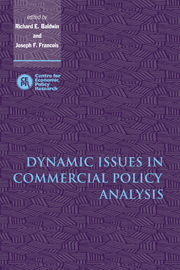Book contents
- Frontmatter
- Contents
- List of figures
- List of tables
- Preface
- List of conference participants
- 1 Introduction
- 2 Transition dynamics and trade policy reform in developing countries
- 3 Putting growth effects in computable equilibrium trade models
- 4 Innovation, capital accumulation, and economic transition
- 5 Multinational production, skilled labour, and real wages
- 6 Economic policy and the manufacturing base: hysteresis in location
- 7 Trade liberalization and investment in a multilateral framework
- 8 Investment creation and investment diversion: simulation analysis of the Single Market programme
- 9 Blueprints, spillovers, and the dynamic gains from trade liberalization in a small open economy
- 10 Trade policy and North–South migration
- 11 Long-term modelling of trade and environmental linkages
- 12 Labour markets and dynamic comparative advantage
- Index
4 - Innovation, capital accumulation, and economic transition
Published online by Cambridge University Press: 13 January 2010
- Frontmatter
- Contents
- List of figures
- List of tables
- Preface
- List of conference participants
- 1 Introduction
- 2 Transition dynamics and trade policy reform in developing countries
- 3 Putting growth effects in computable equilibrium trade models
- 4 Innovation, capital accumulation, and economic transition
- 5 Multinational production, skilled labour, and real wages
- 6 Economic policy and the manufacturing base: hysteresis in location
- 7 Trade liberalization and investment in a multilateral framework
- 8 Investment creation and investment diversion: simulation analysis of the Single Market programme
- 9 Blueprints, spillovers, and the dynamic gains from trade liberalization in a small open economy
- 10 Trade policy and North–South migration
- 11 Long-term modelling of trade and environmental linkages
- 12 Labour markets and dynamic comparative advantage
- Index
Summary
Introduction
The demise of communism in Central and East European countries (CEECs) has set the European continent on a path of rapid change, challenging economic policy makers not only in post-communist countries themselves but also in Western Europe. Having rid themselves of communist governments in 1989–90, people in the CEECs soon faced dubious rewards. Their economies experienced an unprecedented crisis, with successive double-digit annual reductions in real GDP and mass unemployment. Lacking both previous historical experience and an accepted theory of systemic transformation, observers had a hard time interpreting what was going on. Was it an unavoidable prelude to the formation of a capitalist system, something along the lines of Schumpeter's creative destruction? Were these countries actually heading towards a capitalist system of the Western type, or were they trying to go for some idiosyncratic mixture of communist–capitalist society? In the meantime, economists more or less unanimously agree that the CEECs will eventually emerge as market economies of the Western type, and that they will do so to their own great advantage. However, controversy still dominates as to the detailed policies of transformation. This holds true in particular with respect to privatization and industrial restructuring, while historical experience and theory seemingly offer somewhat more guidance on issues of macroeconomic stabilization.
Given the necessity of immediate action, it is not surprising that much of the discussion has so far centred on policies pertaining to systemic transformation, as for instance evidenced by Clague and Rausser (1992), and Blanchard et al. (1992).
- Type
- Chapter
- Information
- Dynamic Issues in Commercial Policy Analysis , pp. 89 - 137Publisher: Cambridge University PressPrint publication year: 1999
- 4
- Cited by



